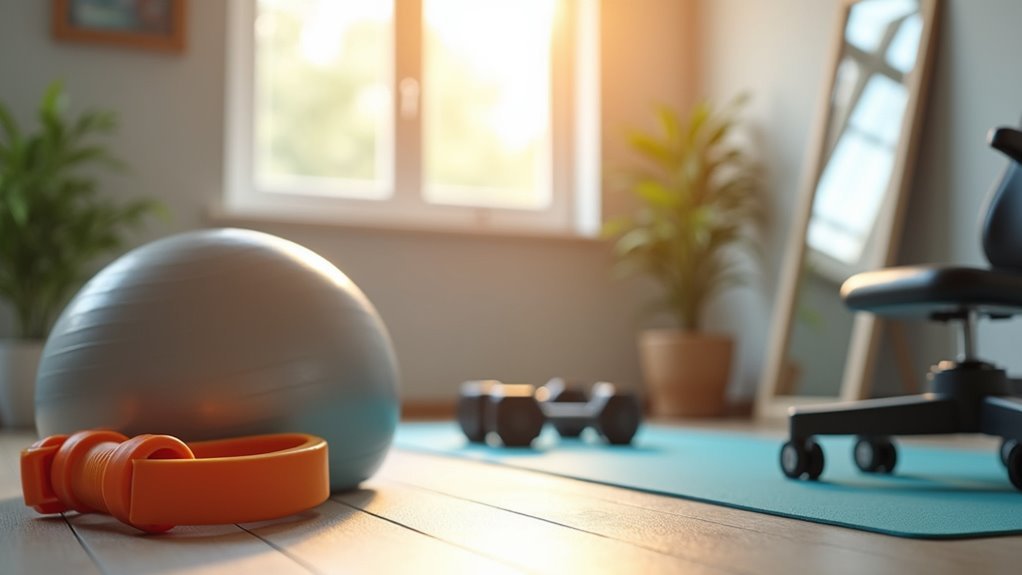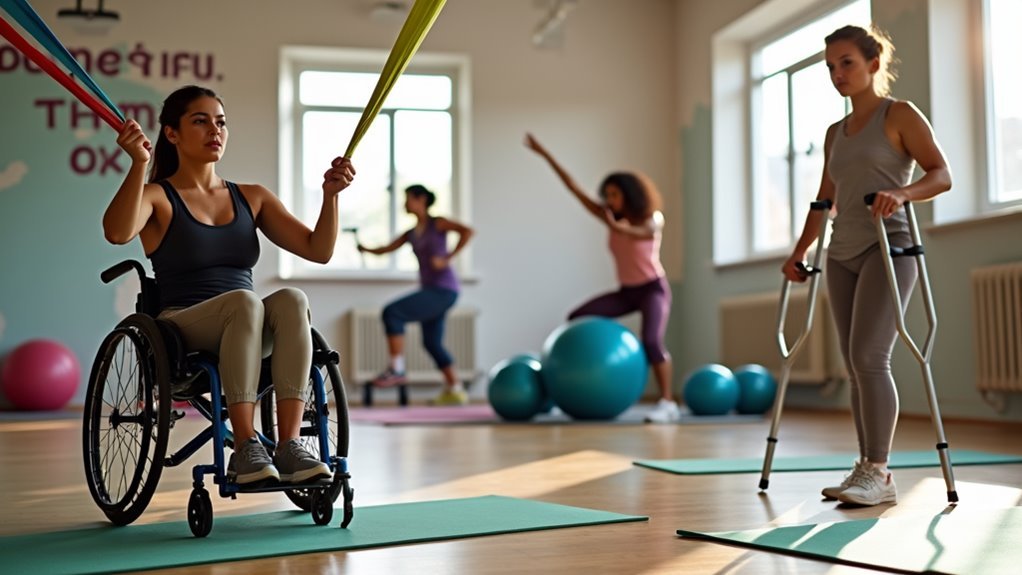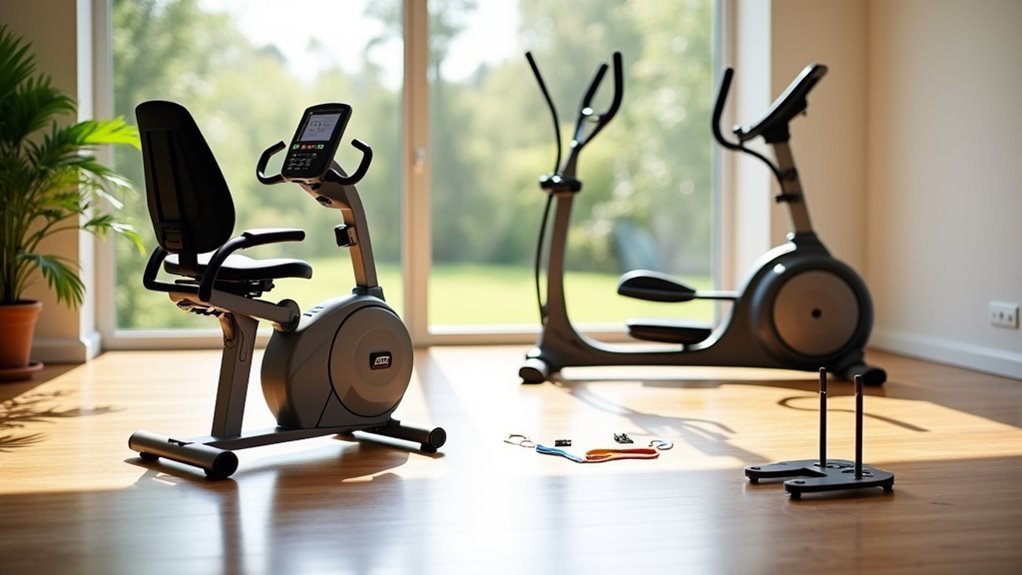You’ll find exceptional balance improvement through seven key aquatic workouts: water walking with opposite arm-leg coordination, standing balance challenges on single legs, targeted leg swings and hip movements, core strengthening routines using water resistance, arm and upper body stability exercises, tandem walking drills with heel-to-toe placement, and gentle aqua yoga sequences. Water’s buoyancy protects your joints while providing safe resistance training that builds proprioception, reduces fall risk, and enhances daily mobility confidence. These all-encompassing techniques offer transformative results for active aging.
Water Walking and Marching Exercises

When you’re looking for gentle yet effective exercises that build strength and stability, water walking and marching offer the perfect solution for your fitness routine.
Water walking involves maintaining an upright posture while engaging your core and using opposite arm and leg motions to enhance coordination. This exercise builds muscular strength without aggravating joint pain, making it ideal for seniors.
Water walking builds strength while protecting joints through coordinated movements and core engagement, making it perfect for seniors seeking low-impact exercise.
Marching exercises, particularly high knee marches, help improve balance by requiring you to balance on one leg for several seconds with each step. You can adjust intensity by increasing speed or using swim spa currents.
These activities promote flexibility and balance while reducing your risk of falling. Regular practice considerably enhances mobility confidence, making daily activities safer.
Standing Balance Challenges in Shallow Water
You’ll find that standing balance challenges in shallow water offer an excellent progression from your water walking routine.
Start with basic standing stability exercises like single-leg stands while holding the pool edge, then gradually advance to more challenging movements as your confidence grows.
These progressive balance challenges will strengthen your core muscles and improve your proprioception, helping you feel more stable both in and out of the water.
Basic Standing Stability Exercises
Standing balance exercises in shallow water offer seniors a perfect starting point for building stability while minimizing injury risk. Water’s buoyancy provides natural support while you perform standing stability exercises that improve balance and reduce the risk of falls. These safe and effective water exercises challenge your stability without the fear of hard impacts.
| Exercise | Technique |
|---|---|
| Heel Raises | Rise onto toes, hold 3 seconds, lower slowly |
| Hip Abductions | Lift leg sideways, maintain upright posture |
| Single-Leg Stands | Balance on one foot, use arms for stability |
| Weight Shifts | Transfer weight side-to-side, front-to-back |
| Ankle Circles | Rotate each ankle while standing on opposite leg |
Water’s natural resistance builds core strength while you maintain proper form, making everyday movements more confident and controlled.
Progressive Balance Challenges
Once you’ve mastered basic standing stability moves, it’s time to advance to more challenging balance exercises that’ll further strengthen your coordination and fall-prevention skills.
Standing balance challenges in shallow water provide an ideal progression for seniors seeking to improve their stability. Try tandem walking or single-leg stands while water’s buoyancy creates a safe training environment.
These exercises reduce fall risk considerably when performed regularly, as research confirms. The water resistance strengthens muscles while protecting you from injury during challenging movements.
You’ll enhance proprioception—your body’s spatial awareness—which directly improves balance. Progressively increase duration or movement speed as your confidence grows, ensuring continuous improvement in your coordination and overall stability.
Leg Swings and Hip Movements

Three key movements transform your aquatic workout into a powerful tool for hip flexibility and fall prevention. Leg swings performed in water create a low-impact environment that strengthens your hips while reducing risk of injury. These hip movements target your gluteus medius and minimus muscles, essential for balance and core strength.
| Exercise | Primary Target | Benefits |
|---|---|---|
| Forward Leg Swings | Hip Flexors | Improves forward mobility |
| Side Leg Swings | Gluteus Medius | Enhances lateral stability |
| Backward Leg Swings | Hip Extensors | Strengthens posterior chain |
| Hip Circles | Full Hip Range | Increases flexibility |
| Standing Marches | Core Integration | Boosts proprioception |
Water’s resistance provides effective muscle strengthening while protecting your joints. Regular practice will improve coordination and proprioception, helping you better understand your body position and dramatically reducing fall risk.
Core Strengthening Aquatic Routines
While your legs and hips provide the foundation for movement, your core serves as the central powerhouse that keeps you upright and stable throughout daily activities.
Core strengthening through water aerobic exercises offers exceptional benefits for improving balance and reducing fall risk. Water’s natural resistance allows you to engage deeper abdominal muscles without joint strain. These exercises offer buoyancy support while challenging your stability muscles effectively.
Water aerobics strengthens your core while protecting joints, delivering superior balance improvements and fall prevention through natural resistance training.
Try standing hip abduction movements, where you lift your leg sideways against water resistance. Flutter kicks while holding the pool wall target your entire core region.
Water’s properties let you maintain proper posture during each movement, enhancing body alignment. Regular participation builds confidence, helping you prevent injuries and stay active in daily life with improved coordination and strength.
Arm and Upper Body Stability Exercises

You’ll find that water resistance arm training transforms ordinary movements into powerful strength-building exercises that protect your joints while challenging your muscles.
The buoyant environment lets you perform push-ups, arm curls, and resistance movements with up to 15 times more resistance than air-based workouts.
These exercises naturally engage your core stabilization techniques, creating an extensive upper body workout that improves your balance and reduces fall risk.
Water Resistance Arm Training
Harness the natural resistance of water to build impressive upper body strength through targeted arm training exercises.
Water resistance arm training offers seniors an ideal way to enhance muscle tone while protecting joints from injury. The water’s buoyancy supports your body weight, making movements safer and more controlled than traditional weightlifting.
Regular aquatic arm workouts help improve coordination and greatly reduce your risk of falls by strengthening stabilizing muscles. You’ll maintain independence in daily activities while staying active in a low-impact environment.
Essential water resistance exercises for seniors include:
- Arm curls – Stand chest-deep and curl arms against water resistance
- Water push-ups – Use pool wall for modified upper body strengthening
- Cross-body reaches – Enhance coordination and core stability
- Shoulder blade squeezes – Improve posture and cardiovascular health
Core Stabilization Techniques
Building core stability transforms your balance and strengthens your entire upper body through targeted aquatic exercises. Core stabilization techniques engage your deep abdominal muscles while water’s resistance challenges your stability naturally.
You’ll perform water push-ups against the pool wall, keeping your core tight throughout each movement. This upper body exercise simultaneously activates stabilizing muscles that improve your posture and reduce fall risk.
Water weights add resistance to arm curls and lateral raises, forcing your core to work harder for balance. These movements are easy on the joints while building functional strength.
The buoyant environment lets you focus on proper form without joint stress. Regular practice of these stabilization exercises will improve mood through increased confidence and considerably lower your risk of falls.
Tandem Walking and Coordination Drills
When you step one foot directly in front of the other in tandem walking, you’re challenging your balance and coordination in ways that mirror everyday movements like maneuvering through narrow hallways or walking on uneven surfaces.
Practicing this exercise while exercising in the water provides extra support and resistance, making it safer for your joints while still strengthening your leg muscles effectively.
Water aerobics exercises like tandem walking offer excellent fall prevention benefits by improving your proprioception and muscle tone.
You can enhance these coordination drills by adding arm movements that oppose your leg patterns.
- Move your right arm forward when stepping with your left foot
- Practice heel-to-toe placement for maximum balance challenge
- Start with shorter distances and gradually increase length
- Combine tandem walking with gentle arm circles for added coordination
Gentle Aqua Yoga and Stretching Sequences
How can you take your aquatic balance training to the next level while nurturing your body’s natural flexibility? Gentle aqua yoga offers the perfect solution, using the buoyancy of water to support your body while executing poses with reduced joint strain. These stretching sequences enhance your range of motion and improve coordination through slow, controlled movements that build body awareness.
| Movement Type | Balance Benefits |
|---|---|
| Water-supported poses | Enhanced stability and confidence |
| Breathing exercises | Improved mental well-being and focus |
| Flowing sequences | Better coordination and fall prevention |
Regular participation in gentle aqua yoga can greatly reduce fear of falling while fostering balance improvement. The combination of physical stretching and relaxation techniques promotes both bodily strength and mental well-being, creating a thorough approach to maintaining your mobility and independence.
Frequently Asked Questions
What Is the Number 1 Exercise to Increase Balance in Seniors?
Water walking’s the number one exercise you should do to increase your balance. It’ll engage your core muscles while water’s buoyancy supports you, reducing fall risks and improving coordination safely.
Does Aqua Therapy Improve Balance?
Yes, aqua therapy considerably improves your balance by enhancing proprioception and strengthening core muscles. Water’s buoyancy reduces fall risk while its resistance challenges you to stabilize, making movements safer yet effective for balance training.
What Is the Best Water Exercise for Seniors?
You’ll find water walking is your best choice since it enhances coordination and balance while reducing fall risk. The water’s buoyancy supports you, making it safer than land-based exercises.
Is Aqua Aerobics Good for Seniors?
Yes, aqua aerobics is excellent for you as a senior. You’ll enjoy low-impact exercise that strengthens muscles, improves balance, and reduces joint stress. It’s safe, effective, and helps prevent falls while boosting confidence.
In Summary
You’ve now discovered seven effective aquatic workouts that’ll greatly enhance your balance and stability. Water’s buoyancy reduces fall risk while providing gentle resistance for strength building. You’ll find these exercises particularly beneficial because they’re low-impact yet highly effective for improving coordination and core strength. Start slowly with basic water walking, then gradually incorporate more challenging movements. Remember, consistency is key – practice these routines regularly to see the best balance improvements.





Leave a Reply